Comparison of the Declared and Simulated Real-Use Noise Data during Wood Sanding Using a Hand-Held Power Sander
Abstract
:1. Introduction
2. Materials and Methods
2.1. Experimental Setup and Design
2.2. Description of Sanders under Test
2.3. Test Specimens
2.4. Noise Measurement Instrumentation
2.5. Measurement Procedure
2.6. Data Analysis
3. Results
3.1. Measured Values of Equivalent Noise Level at Sander Operator´s Ear
3.2. Comparing Simulated Real-Use and Declared Noise Data
4. Discussion
5. Conclusions
- Declared noise emission values in risk assessments underestimate the magnitude of operator noise exposure;
- No statistically significant differences were found when the coarse-grit sandpaper was compared to medium-grit and fine-grit varieties in terms of emitted noise during sanding tasks;
- By comparing the measured noise data from both beech wood and spruce wood sanding, no statistically significant difference between these two wood species was observed.
Author Contributions
Funding
Data Availability Statement
Acknowledgments
Conflicts of Interest
References
- Šolc, M. Noise in the Occupational Environment as One of Important Factors Affecting Human Quality of Life. Prevence Úrazů Otrav Násilí 2011, 7, 85–91. [Google Scholar]
- Piňosová, M.; Andrejiová, M.; Lumnitzer, E. Occupational Noise Exposure and Hearing Impairment among Employees’ in Car Service Operations. Calitatea Acces Success 2019, 20, 158–164. [Google Scholar]
- National Health Information Centre: Occupational Diseases or Threats of Occupational Diseases in the Slovak Republic 2021. Available online: https://www.nczisk.sk/Statisticke_vystupy/Tematicke_statisticke_vystupy/Choroby_povolania_alebo_ohrozenia_chorobou_povolania/Pages/default.aspx (accessed on 13 March 2023).
- European Commission. Directive 2003/10/EC of the European Parliament and of the Council of 6 February 2003 on the Minimum Health and Safety Requirements Regarding the Exposure of Workers to the Risks Arising from Physical Agents (Noise); European Commission: Brussels, Belgium, 2003. [Google Scholar]
- ISO 4871:1996; Acoustics—Declaration and Verification of Noise Emission Values of Machinery and Equipment. International Organization for Standardization: Geneva, Switzerland, 1996.
- Pędzik, M.; Rogoziński, T.; Majka, J.; Stuper-Szablewska, K.; Antov, P.; Kristak, L.; Kminiak, R.; Kučerka, M. Fine Dust Creation during Hardwood Machine Sanding. Appl. Sci. 2021, 11, 6602. [Google Scholar] [CrossRef]
- Pędzik, M.; Stuper-Szablewska, K.; Sydor, M.; Rogoziński, T. Influence of Grit Size and Wood Species on the Granularity of Dust Particles during Sanding. Appl. Sci. 2020, 10, 8165. [Google Scholar] [CrossRef]
- Dado, M.; Salva, J.; Schwarz, M.; Vanek, M.; Bustin, L. Effect of Grit Size on Airborne Particle Concentration and Size Distribution during Oak Wood Sanding. Appl. Sci. 2022, 12, 7644. [Google Scholar] [CrossRef]
- Sydor, M.; Mirski, R.; Stuper-Szablewska, K.; Rogoziński, T. Efficiency of Machine Sanding of Wood. Appl. Sci. 2021, 11, 2860. [Google Scholar] [CrossRef]
- Očkajová, A.; Kučerka, M.; Kminiak, R.; Banski, A. Sustainable Manufacturing Process in the Context of Wood Processing by Sanding. Coatings 2021, 11, 1463. [Google Scholar] [CrossRef]
- Dado, M.; Mikusova, L.; Schwarz, M.; Hnilica, R. Effect of selected factors on mass concentration of airborne dust during wood sanding. MM Sci. J. 2019, 2019, 3679–3682. [Google Scholar] [CrossRef]
- Sydor, M.; Majka, J.; Hanincová, L.; Kučerka, M.; Kminiak, R.; Kristak, L.; Pędzik, M.; Očkajová, A.; Rogoziński, T. Fine Dust after Sanding Untreated and Thermally Modified Spruce, Oak, and Meranti Wood. Eur. J. Wood Prod. 2023, 81, 1455–1464. [Google Scholar] [CrossRef]
- Gauthier, F.; Gélinas, D.; Marcotte, P. Vibration of Portable Orbital Sanders and Its Impact on the Development of Work-Related Musculoskeletal Disorders in the Furniture Industry. Comput. Ind. Eng. 2012, 62, 762–769. [Google Scholar] [CrossRef]
- Tekavec, E.; Löfqvist, L.; Larsson, A.; Fisk, K.; Riddar, J.; Nilsson, T.; Nordander, C. Adverse Health Manifestations in the Hands of Vibration Exposed Carpenters—A Cross Sectional Study. J. Occup. Med. Toxicol. 2021, 16, 16. [Google Scholar] [CrossRef]
- Carra, S.; Monica, L.; Vignali, G. Reduction of Workers’ Hand-Arm Vibration Exposure through Optimal Machine Design: AHP Methodology Applied to a Case Study. Saf. Sci. 2019, 120, 706–727. [Google Scholar] [CrossRef]
- Shi, L.; Sun, B. Mathematical Modeling and Vibration Simulation of an Orbital Sander. Vibroeng. Procedia 2019, 22, 176–181. [Google Scholar] [CrossRef]
- Schröder, T.; Lindenmann, A.; Resch, A.; Matthiesen, S.; Gwosch, T. Influence of Coupling Forces on the Mechanical Impedance of the Hand-Arm System during Rotational Vibration Excitation around the Xh-Axis. Int. J. Ind. Ergon. 2023, 95, 103427. [Google Scholar] [CrossRef]
- Zheng, Y.-P.; Juang, Y.-J.; Yiin, L.-M. Modeling of Woodworkers’ Exposure to Occupational Noises by Integrating Frequency Spectra Generated by Power Tools: A Pilot Study. Appl. Sci. 2020, 10, 6453. [Google Scholar] [CrossRef]
- Steel, C.; Hawker, A. Influencing Companies to Purchase Lower Noise Tool Consumables? Inter-Noise Noise-Con Congr. Conf. Proc. 2023, 265, 5077–5088. [Google Scholar] [CrossRef]
- Lowry, D.M.; Fritschi, L.; Mullins, B.J. Occupational Noise Exposure of Utility Workers Using Task Based and Full Shift Measurement Comparisons. Heliyon 2022, 8, e09747. [Google Scholar] [CrossRef]
- Wang, Z.; Stone, R.T.; Kim, J.Y.M. Hand Tool Evaluation: A Review of Existing Hand Tool Evaluation and Selection Studies. Int. J. Hum. Factors Ergon. 2023, 10, 15. [Google Scholar] [CrossRef]
- EN 62841-1:2015/A11:2022; Electric Motor-Operated Hand-Held Tools, Transportable Tools and Lawn and Garden Machinery. Safety—General Requirements. The European Committee for Electrotechnical Standardization: Brussels, Belgium, 2022.
- EN 62841-2-4:2014; Electric Motor-Operated Hand-Held Tools, Transportable Tools and Lawn and Garden Machinery—Safety—Part 2-4: Particular Requirements for Hand-Held Sanders and Polishers Other Than Disc Type (IEC 62841-2-4:2014, Modified). The European Committee for Electrotechnical Standardization: Brussels, Belgium, 2014.
- Patel, J.; Brereton, P. A Critical Review of the Standard Methods Used to Determine Emission Sound Pressure Level, Peak Sound Pressure Level and Sound Power Level as Required by Machinery Directive 2006/42/EC; HSE Research Report RR1116; Health and Safety Executive: Buxton, UK, 2017. Available online: http://www.hse.gov.uk/research/rrpdf/rr1116.pdf (accessed on 25 August 2023).
- Brereton, P.; Patel, J. Buy Quiet as a Means of Reducing Workplace Noise. Acoust. Aust. 2016, 44, 55–65. [Google Scholar] [CrossRef]
- Patel, J.; Hewitt, S. Supply of Sanders—Quality of Manufacturers’ Noise and Vibration Declarations; Office for Official Publications of the European Communities: Luxembourg, 2016; ISBN 92-828-6706-4. [Google Scholar]
- Shanks, E. Correlation of Noise Emission of Sanders and Polishers with in Use Noise Levels; HSL Report HSL/2007/43; Health and Safety Executive: Buxton, UK, 2007. Available online: https://www.hse.gov.uk/research/hsl_pdf/2007/hsl0743.pdf (accessed on 31 January 2016).
- European Commission. Directorate-General for Employment, Social Affairs and Inclusion. In Non-Binding Guide to Good Practice for the Application of Directive 2003/10/EC “Noise at Work”—Cd; Publications Office: Luxembourg, 2010. [Google Scholar]
- ISO 12001:1996; Acoustics—Noise Emitted by Machinery and Equipment—Rules for the Drafting and Presentation of a Noise Test Code. International Organization for Standardization: Geneva, Switzerland, 1996.
- Mikušová, L.; Očkajová, A.; Dado, M.; Kučera, M.; Danihelová, Z. Thermal Treatment’s Effect on Dust Emission during Sanding of Meranti Wood. BioResources 2019, 14, 5316–5326. [Google Scholar] [CrossRef]
- ISO 13061-2; Physical and Mechanical Properties of Wood—Test Methods for Small Clear Wood Specimens—Part 2: Determination of Density for Physical and Mechanical Tests. International Organization for Standardization: Geneva, Switzerland, 2014.
- IEC 61672-1:2013; Electroacoustics—Sound Level Meters—Part 1: Specifications. International Electrotechnical Commission: Geneva, Switzerland, 2013.
- European Parliament and of the Council. Directive 2006/42/EC of the European Parliament and of the Council of 17 May 2006 on Machinery, and Amending Directive 95/16/EC (Recast); European Parliament and of the Council: Brussels, Belgium, 2006. [Google Scholar]
- Svoreň, J.; Naščák, Ľ.; Koleda, P.; Barcík, Š.; Němec, M. The Circular Saw Blade Body Modification by Elastic Material Layer Effecting Circular Saws Sound Pressure Level When Idling and Cutting. Appl. Acoust. 2021, 179, 108028. [Google Scholar] [CrossRef]
- Kováč, J.; Krilek, J.; Dado, M.; Beňo, P. Investigating the Influence of Design Factors on Noise and Vibrations in the Case of Chainsaws for Forestry Work. FME Trans. 2018, 46, 513–519. [Google Scholar] [CrossRef]
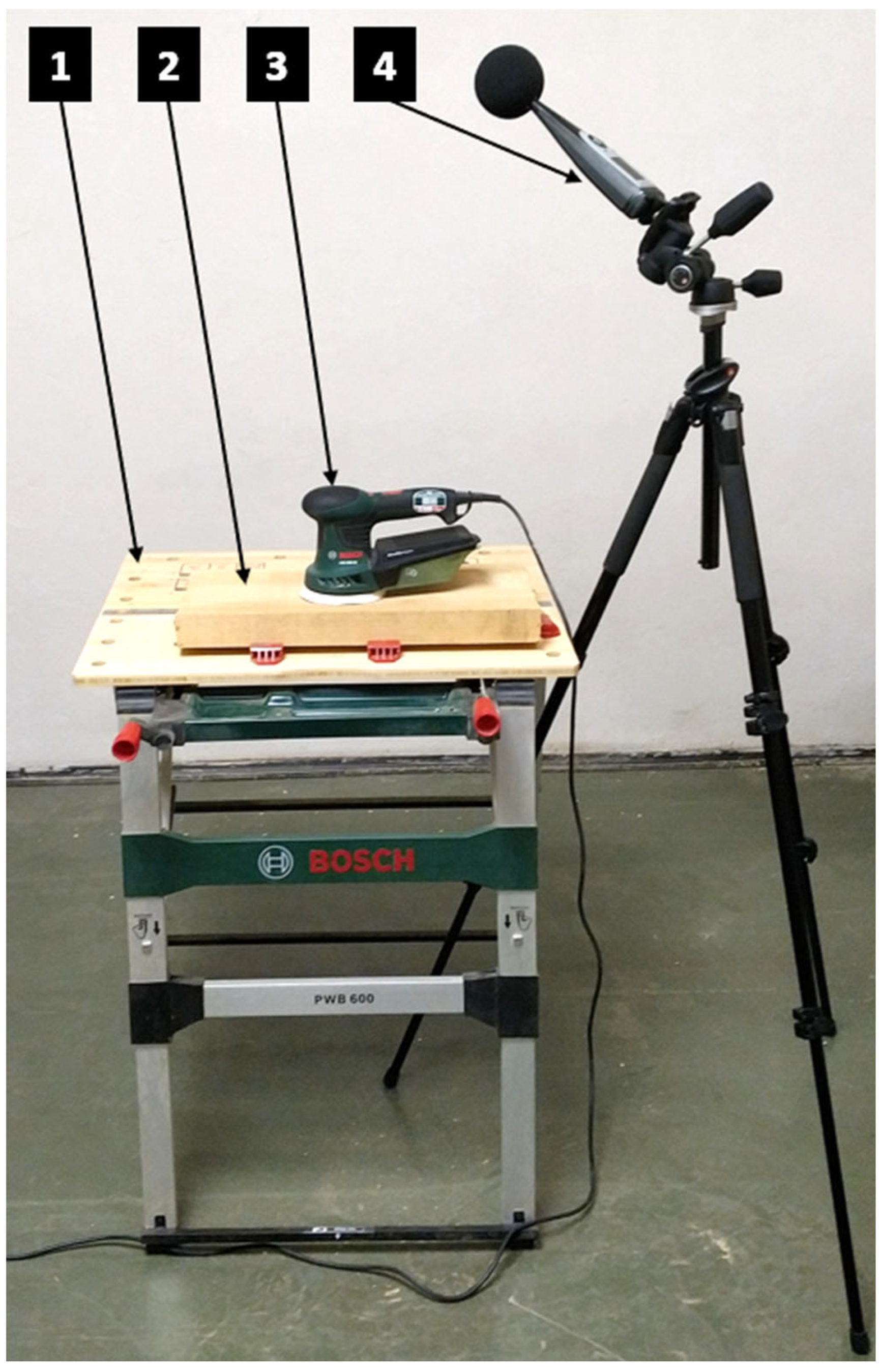
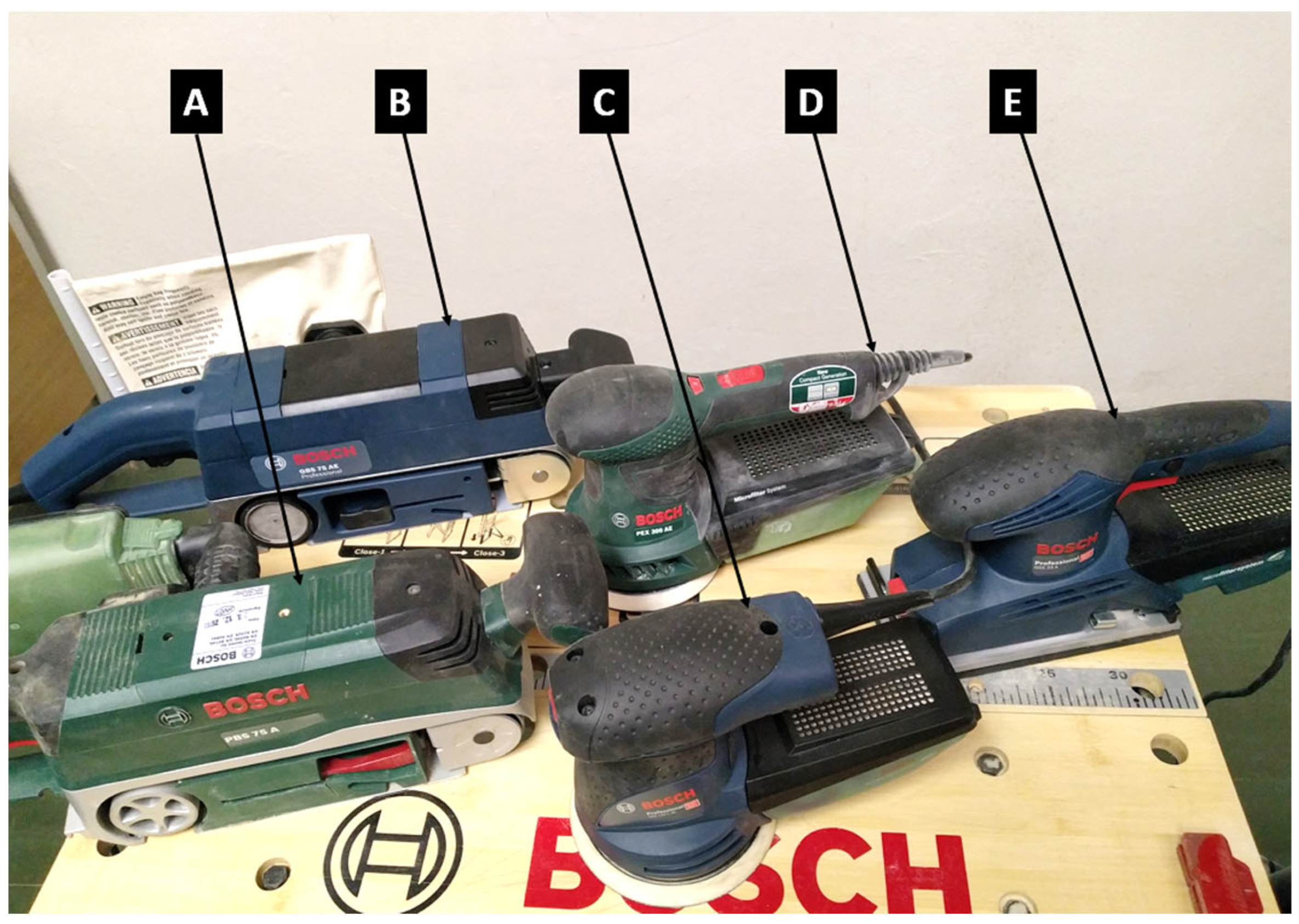
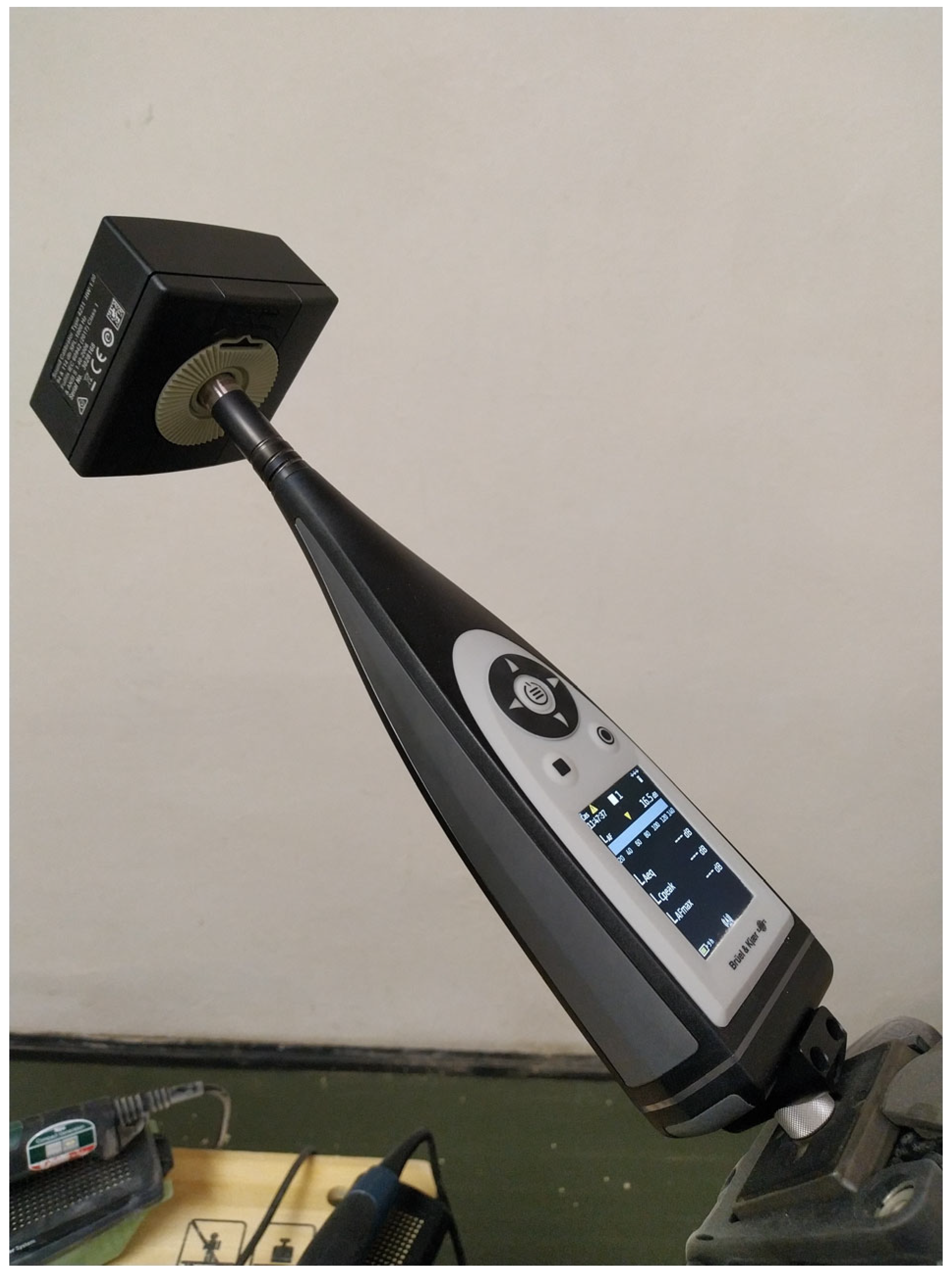
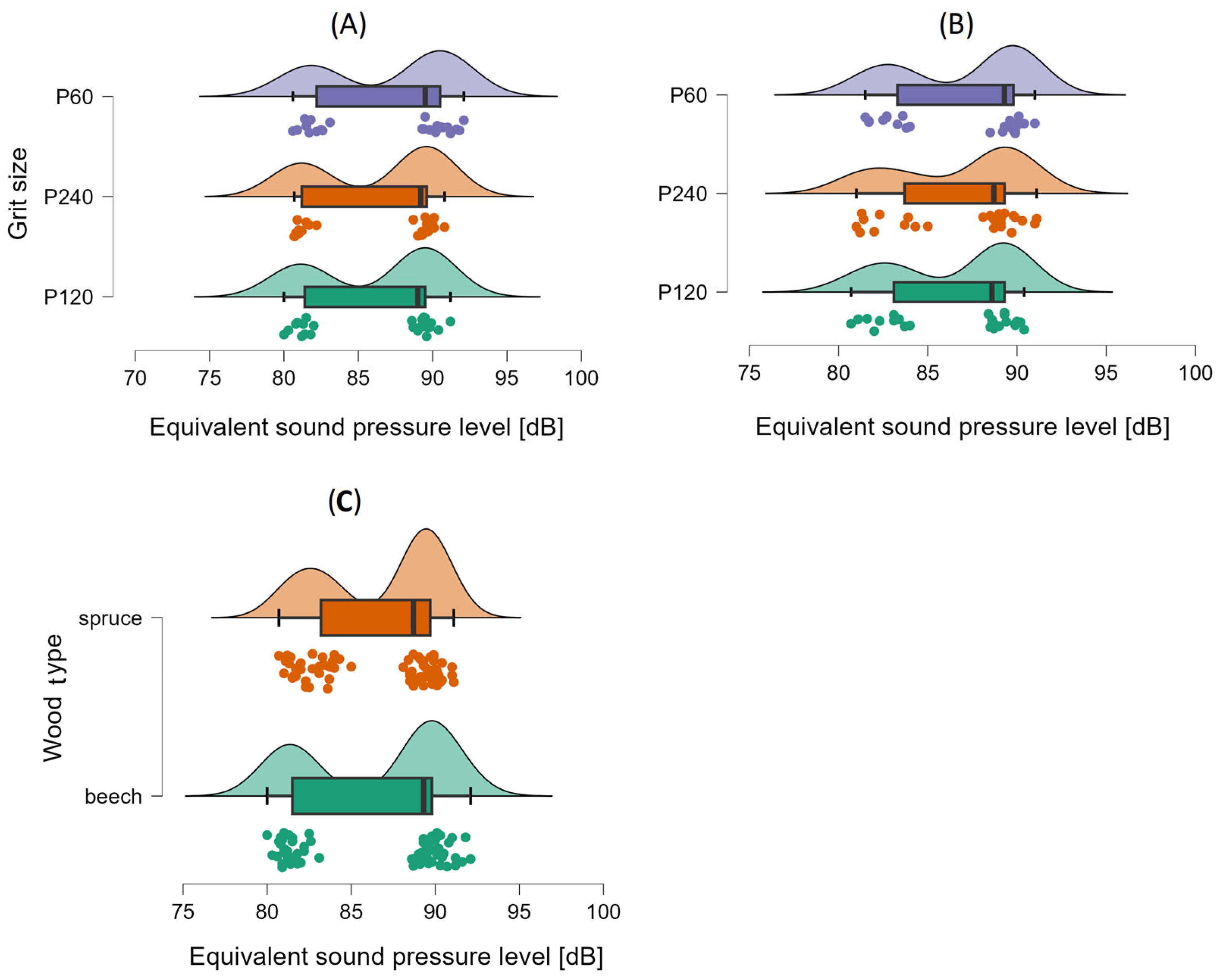
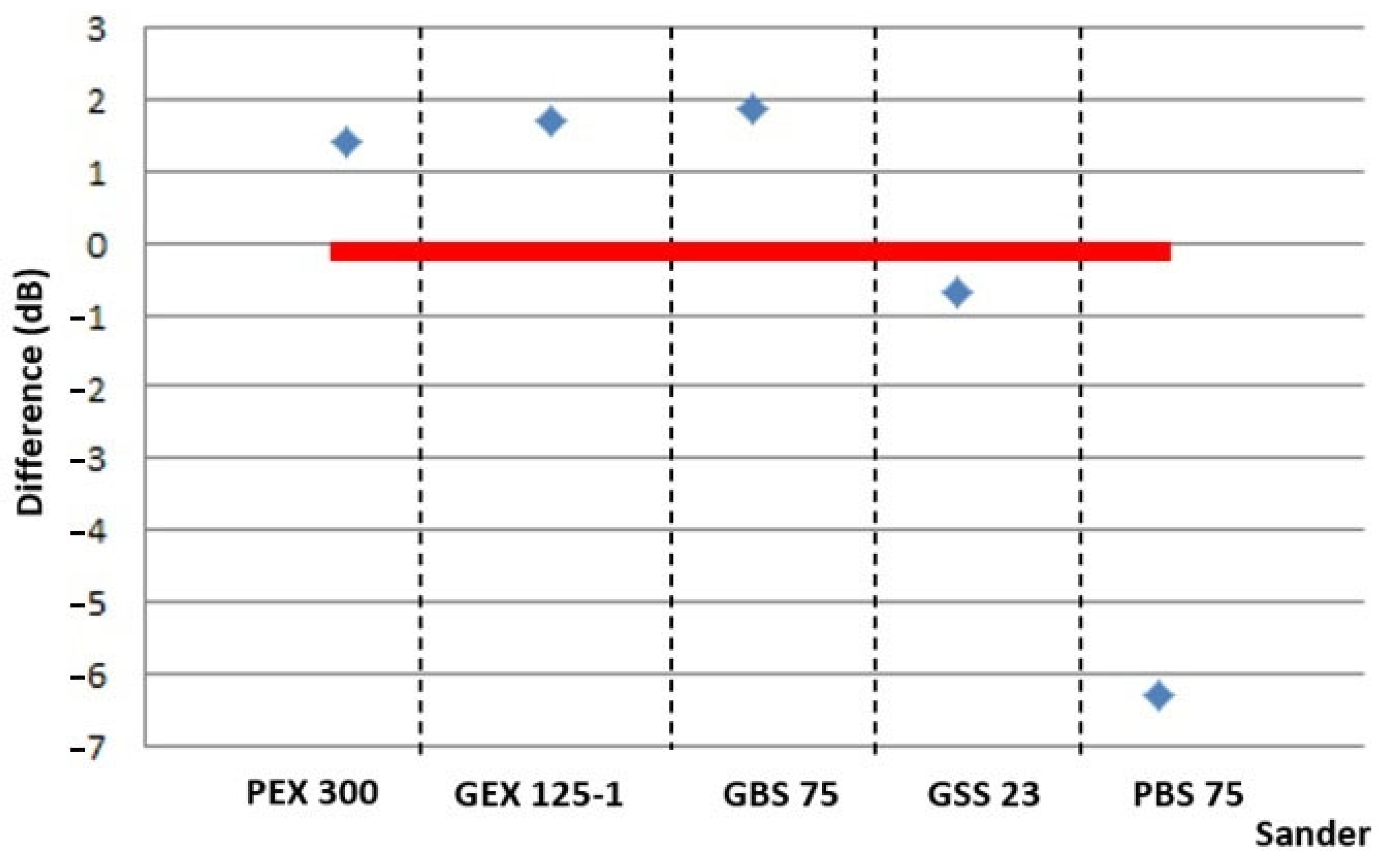
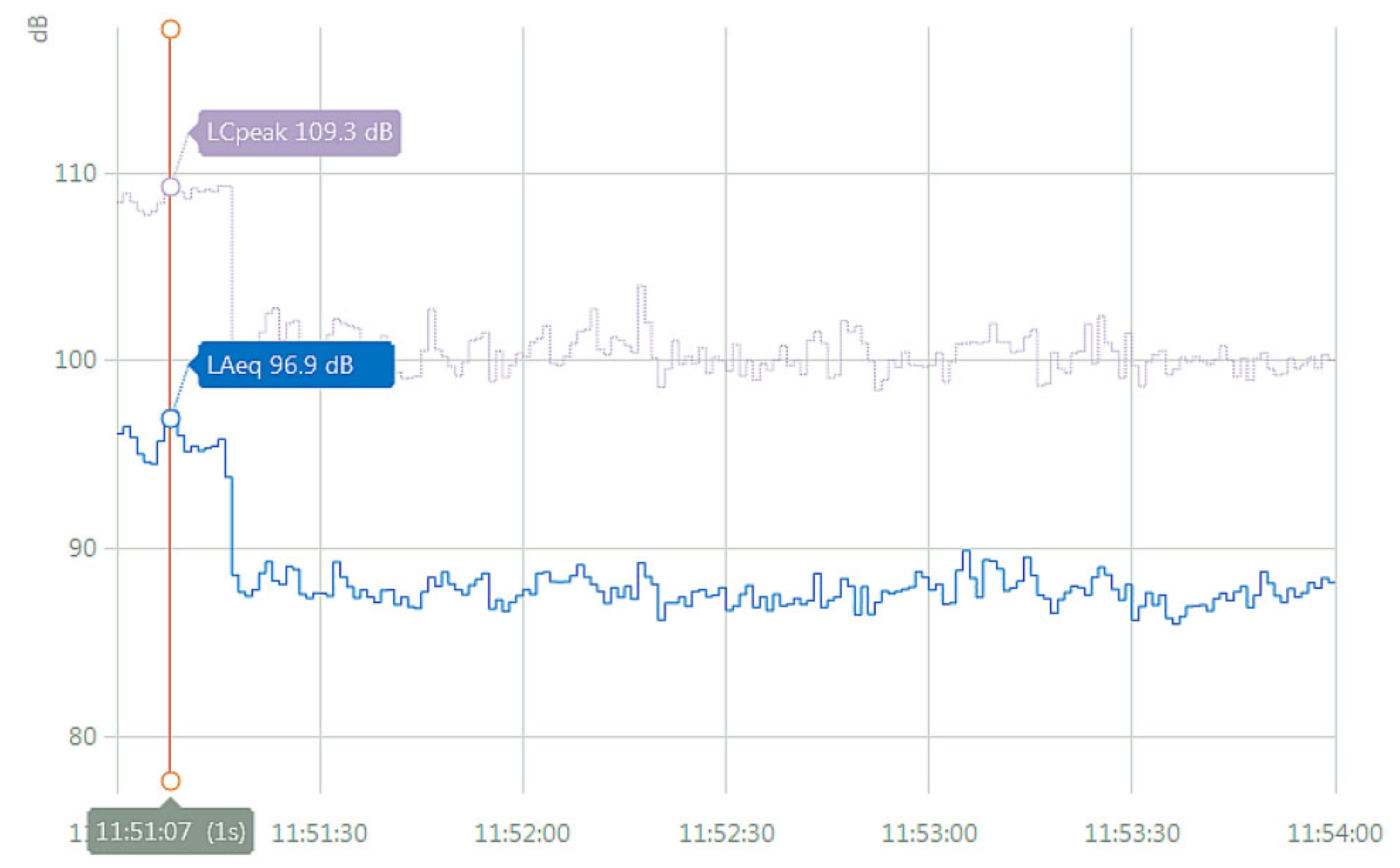
| Sander | Belt Speed/Stroke Rate | Sound Power Level LWA (dB) | Sound Pressure Level LPA (dB) | Uncertainty K (-) |
|---|---|---|---|---|
| A | no-load belt speed: 350 m/min | 104 | 93 | 3 |
| B | no-load belt speed: 330 m/min | 96 | 85 | 3 |
| C | no-load orbital stroke rate: 24,000/min | 88 | 77 | 3 |
| D | 96 | 85 | 3 | |
| E | 91 | 80 | 3 |
| Parameter | Specification |
|---|---|
| Species | beech (Fagus silvatica L.), spruce (Picea abies (L.) H. Karst) |
| Origin | Zvolen region, Central Slovakia, Supplier—University Forest Enterprise |
| Density | spruce ∼380 kg/m3 beech ∼590 kg/m3 |
| Moisture content | The specimens were dried naturally at 20 ± 1 °C. |
| Fiber direction | 0° tangential cut/longitudinal tangential plane |
| Sander | Sandpaper Grit | Wood Species | Sound Pressure Level LAeq (dB) |
|---|---|---|---|
| A | P60 | beech | 90.3 ± 0.4 |
| spruce | 89.9 ± 0.3 | ||
| P120 | beech | 89.3 ± 0.2 | |
| spruce | 89.9 ± 0.3 | ||
| P240 | beech | 89.3 ± 0.1 | |
| spruce | 89.8 ± 0.3 | ||
| B | P60 | beech | 90.7 ± 1.1 |
| spruce | 90.0 ± 0.6 | ||
| P120 | beech | 90.0 ± 0.9 | |
| spruce | 89.0 ± 0.3 | ||
| P240 | beech | 89.7 ± 0.4 | |
| spruce | 89.9 ± 0.9 | ||
| C | P60 | beech | 82.4 ± 0.5 |
| spruce | 82.3 ± 0.7 | ||
| P120 | beech | 81.0 ± 0.6 | |
| spruce | 81.5 ± 0.6 | ||
| P240 | beech | 81.3 ± 0.5 | |
| spruce | 81.4 ± 0.3 | ||
| D | P60 | beech | 90.5 ± 0.9 |
| spruce | 89.4 ± 0.5 | ||
| P120 | beech | 89.3 ± 0.4 | |
| spruce | 88.9 ± 0.8 | ||
| P240 | beech | 89.8 ± 0.7 | |
| spruce | 88.6 ± 0.3 | ||
| E | P60 | beech | 81.3 ± 0.5 |
| spruce | 83.2 ± 0.9 | ||
| P120 | beech | 81.2 ± 0.6 | |
| spruce | 83.5 ± 0.4 | ||
| P240 | beech | 81.1 ± 0.3 | |
| spruce | 83.8 ± 0.9 |
| Wood Type | Factor | Statistic H | df | p Value |
|---|---|---|---|---|
| beech | grit size | 4.891 | 2 | 0.087 |
| spruce | grit size | 1.093 | 2 | 0.579 |
| - | wood type | 0.009 | 1 | 0.924 |
Disclaimer/Publisher’s Note: The statements, opinions and data contained in all publications are solely those of the individual author(s) and contributor(s) and not of MDPI and/or the editor(s). MDPI and/or the editor(s) disclaim responsibility for any injury to people or property resulting from any ideas, methods, instructions or products referred to in the content. |
© 2023 by the authors. Licensee MDPI, Basel, Switzerland. This article is an open access article distributed under the terms and conditions of the Creative Commons Attribution (CC BY) license (https://creativecommons.org/licenses/by/4.0/).
Share and Cite
Dado, M.; Schwarz, M.; Salva, J.; Jankovič, R.; Hnilica, R. Comparison of the Declared and Simulated Real-Use Noise Data during Wood Sanding Using a Hand-Held Power Sander. Acoustics 2023, 5, 1136-1147. https://doi.org/10.3390/acoustics5040064
Dado M, Schwarz M, Salva J, Jankovič R, Hnilica R. Comparison of the Declared and Simulated Real-Use Noise Data during Wood Sanding Using a Hand-Held Power Sander. Acoustics. 2023; 5(4):1136-1147. https://doi.org/10.3390/acoustics5040064
Chicago/Turabian StyleDado, Miroslav, Marián Schwarz, Jozef Salva, Richard Jankovič, and Richard Hnilica. 2023. "Comparison of the Declared and Simulated Real-Use Noise Data during Wood Sanding Using a Hand-Held Power Sander" Acoustics 5, no. 4: 1136-1147. https://doi.org/10.3390/acoustics5040064
APA StyleDado, M., Schwarz, M., Salva, J., Jankovič, R., & Hnilica, R. (2023). Comparison of the Declared and Simulated Real-Use Noise Data during Wood Sanding Using a Hand-Held Power Sander. Acoustics, 5(4), 1136-1147. https://doi.org/10.3390/acoustics5040064






